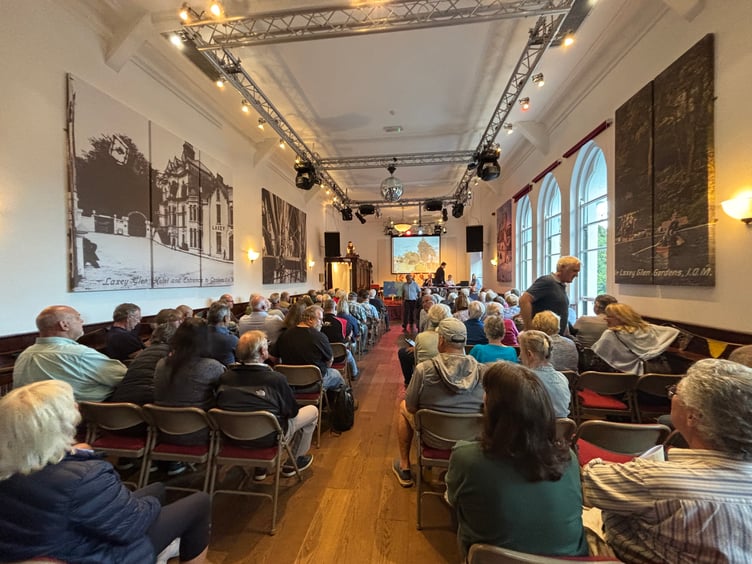A public meeting has underlined deep divisions over plans for a major offshore wind farm off the Isle of Man’s east coast.
The proposals form part of Mooir Vannin Offshore Wind Farm, a scheme being brought forward by Danish renewables company Ørsted. If approved, it would be the first offshore wind farm in Manx territorial waters, which extend 12 nautical miles from the coastline.
Ørsted says the project could bring around £2 billion to the island’s economy over its 35-year operational lifetime, largely through taxation and seabed rental, with additional funding pledged to support local communities. But critics say the turbines - which could reach up to 350 metres in height - would damage the island’s natural environment, its coastal views and its tourism industry.
The application has been made under the Marine Infrastructure Management Act (MIMA). A 12-week public consultation is open, after which the scheme will be referred to a panel of independent experts. That panel will submit a recommendation to the Council of Ministers, which is the final decision-maker.
Chief Minister Alfred Cannan has previously stressed that ministers will not comment on the merits of the proposal while the process is ongoing. He encouraged members of the public to respond to the consultation, saying: ‘Views expressed during this phase can inform and shape the structure of the examination. By submitting a written response you ensure your views are considered prior to the final decision being made.’
Ørsted’s plans cover an area of sea between six and 12 nautical miles off the east coast, stretching from around Maughold Head to Douglas Bay. The company has reduced the number of turbines from 100 to 87, and while the maximum design size is listed at 350 metres, project director Jamie Baldwin said it was unlikely they would reach that height.
‘This is a project which takes years to develop,’ he explained. ‘The figures allow us some flexibility as technology develops. But it is important to be open and honest about the visual impact, while also weighing that against the clear financial, socio-economic and environmental benefits.’
Mr Baldwin said Mooir Vannin could, in theory, supply all of the island’s electricity needs, but the bulk of the power would be exported to the UK. Ørsted has committed to laying a cable to the Isle of Man if government prefers, though connecting it to the local grid would then fall to Manx Utilities.
Beyond tax revenues, Ørsted has pledged up to £1.5 million a year into a Community Investment Fund for the first 15 years, providing £22.5 million to support island initiatives. An operations and maintenance base is also planned for Douglas Harbour, which the company says will create ongoing employment opportunities.
The project stems from the Isle of Man Government’s first Marine Plan, issued in 2014, which led to an Agreement for Lease being signed with Ørsted the following year. Since then, the company has been developing detailed proposals, including environmental assessments of seabirds and marine life. Ørsted says it has worked closely with DEFA and the Manx Wildlife Trust to minimise potential impacts, including noise during construction.
But at last week Tuesday’s meeting, organised by Garff Commissioners to gauge the community’s views on the scheme, only a handful voiced support for the scheme.
The public forum took place at the Laxey Working Men’s Institute and drew around 100 people.
-(1).jpeg?trim=266,0,0,0&width=752&height=501&crop=752:501)
According to the BBC Local Democracy Service, only three residents in attendance were in favour of the plans.
One attendee said he backed it because of the wider climate emergency.
‘I’m deeply concerned about greenhouse gas emissions and the biodiversity crisis,’ he said. ‘There is no perfect solution, but we have to take responsibility as a nation and internationally. Opponents often don’t come forward with viable alternatives. It’s easy to criticise - much harder to propose positive solutions.’
Others were strongly opposed. One man questioned why an independent state should allow a foreign company to develop in its territorial waters for power largely destined for another country.
‘It seems bizarre and mad to me,’ he said. ‘I was involved with a project off the Dorset coast which was rejected despite being far smaller and further offshore. It was turned down because of the visual impact and the risk to tourism. Here we are looking at something on a much bigger scale.’
Businessman David Dorricott, who owns the Mountain View Innovation Centre, warned the project could weaken rather than strengthen the island’s energy security.
‘Energy is really important to all of us, but how we generate it can make us vulnerable,’ he said. ‘The proposals have a massive impact, yet most of the energy is going to the UK. We are compromising our visual estate, our seabed and our tourist industry.
‘Renewables are part of the solution, but they are intermittent. Wind only works when the wind blows, and solar only when the sun shines. We need a proper energy mix to achieve true security. My concern is that this scheme is being promoted as helping our energy security, when in fact it does the opposite.’
Garff Commissioners’ chairman Stan Ryzak said the turnout showed the level of public interest.
‘There was a lot of concern over what’s happening on the east coast,’ he said. ‘It’s not just off Maughold Head as has been suggested - it goes right down to Onchan. That would have a massive impact on the whole east coast of our island.
‘About 70 or 80 people indicated they were against it, and only two or three spoke in favour. We’ll take the views back and continue to discuss them. Ultimately it will be up to politicians in Tynwald to decide, but this is clearly an emotive subject.’
The consultation runs for 12 weeks, after which the independent examining body will draw up a timetable and scope of issues to be considered. Ministers are expected to take a decision within 18 to 24 months.


.jpeg?width=209&height=140&crop=209:145,smart&quality=75)

